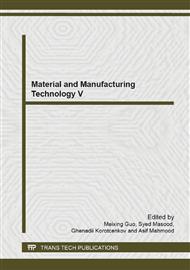[1]
S. Bianca and G. Garth, Disk failure in the real world: What does an MTTF of 1, 000, 000, 000 hours mean to you, ". In Proc of the FAST, 07 Conference on File and Storage Technology, (2007).
Google Scholar
[2]
K.W. Ng, Z. Yuan and B. Liu, Spacing fluctuation induce by disk clamping Distortion, IEEE Transactions on Magnetics, vol. 39, pp.2465-2467, (2003).
DOI: 10.1109/tmag.2003.816439
Google Scholar
[3]
D. Shu, F.F. Yap, B. Gu, B. Shi and D.W. Djmari, Effect of disk clamping conditions on operational shock response of hard disk drives, IEEE Transactions on Magnetics, vol. 47, pp.1874-1877, (2011).
DOI: 10.1109/tmag.2011.2147284
Google Scholar
[4]
W.C. Kim, W.S. Kim and J. Chang, Optimal disk clamp design to minimize stress variation of disks in a hard drive, Journal of Mechanical Science and Technology, vol. 23, pp.2645-2651, (2009).
DOI: 10.1007/s12206-009-0717-5
Google Scholar
[5]
M.S. Raisinghani, H. Ette and R. Pierce, Six Sigma: concepts, tools, and application, Industrial Management & Data System, vol. 105, pp.491-505, (2005).
DOI: 10.1108/02635570510592389
Google Scholar
[6]
J. Antony, M. Kumar, and M.K. Tiwari, An application of Six Sigma methodology to reduce the engine overheating problem in an automotive company, Journal of Engineering Manufacture, vol. 209, pp.633-646, (2005).
DOI: 10.1243/095440505x32418
Google Scholar
[7]
R.B. Anand, S.K. Shukla, A. Ghorpade, M.K. Tiwari and R. Shankare, Six Sigma-based approach to optimize deep drawing operation variables, International Journal of Production Research, vol. 45, pp.2365-2385, (2007).
DOI: 10.1080/00207540600702308
Google Scholar
[8]
S. Coleman, Six Sigma: an opportunity for statistics and for statisticians, Significance, vol. 5, pp.94-96, (2008).
DOI: 10.1111/j.1740-9713.2008.00300.x
Google Scholar
[9]
W. L. Xie, S. Y. Zhou, and Y. Hu, Parameters Optimization for Injection Molding Based on Digital Signal Processing, Applied Mechanics and Materials, vol. 433-435, pp.1890-1893, (2013).
DOI: 10.4028/www.scientific.net/amm.433-435.1890
Google Scholar
[10]
Y. Wu, W. Wu, and J. Ruan, The optimization analysis of the conditions for optimal parameter combination of husker capacity by response surface method, Applied Mechanics and Materials, vol. 433-435, pp.2203-2207, (2013).
DOI: 10.4028/www.scientific.net/amm.433-435.2203
Google Scholar
[11]
W. Kaewon and N. Rojanarowan, Seal strength improvement of valve-regulated lead-acid (VRLA) battery, IOSR Journal of Engineering, vol. 3, pp.39-43, (2013).
DOI: 10.9790/3021-03913943
Google Scholar
[12]
P. Ruthaiputpong and N. Rojanarowan, Improvement of track zero to increase read/write area in hard disk drive assembly process, Uncertain Supply Chain Management, pp.165-176, (2013).
Google Scholar
[13]
W. Sonphuak and N. Rojanarowan, Strength improvement of fibre cement product, International Journal of Industrial Engineering Computations, pp.505-516, (2013).
DOI: 10.5267/j.ijiec.2013.06.004
Google Scholar
[14]
S. Kotz and C.R. Lovelace, Process Capability Indices in Theory and Practice. New York, Arnold, (1998).
Google Scholar
[15]
Y. Fasser and D. Brettner, Process Improvement in the Electronic Industry. 1st ed., J. New York: Wiley & Sons, Inc, (1992).
Google Scholar
[16]
A.I.A. Group, Measurement Systems Analysis, Reference Manual, Automotive Industry Action Group , 3 rd ed. Michigan, (2002).
Google Scholar
[17]
A. Shahin, Integration of FMEA and the Kano model: An exploratory examination, International Journal of Quality& Reliability Management, vol. 21, pp.731-46, (2004).
DOI: 10.1108/02656710410549082
Google Scholar
[18]
Q. Feng, X. Wu, J. Luo, and B. Qi, Research and Application of Special Vehicle Design Based on the FMEA, Applied Mechanics and Materials, vol. 404, pp.171-176, (2013).
DOI: 10.4028/www.scientific.net/amm.404.171
Google Scholar
[19]
T.T. Allen, Statistical Quality Control and Design of Experiments and Systems. 2nd ed. New York: Springer London Dordrecht Heidelberg, (2010).
Google Scholar
[20]
D.C. Montgomery, Applied Statistics and Probability for engineers. 5th ed. New York: Johm Wiley & Sons, Inc, (2011).
Google Scholar


